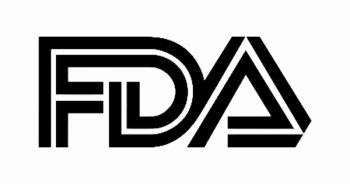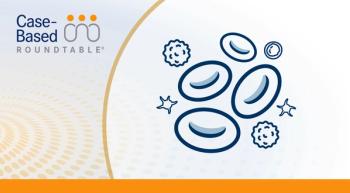
Peers & Perspectives in Oncology
- June I 2025
- Volume 3
- Pages: 25
Renshaw Discusses Addition of Anti-CD20 and BTK/BCL2 Combinations in CLL
During a live event, John S. Renshaw, MD, and other oncologists discussed various trials of novel regimens for patients with chronic lymphocytic leukemia.
EVENT REGION California, Nevada, and Arizona
PARTICIPANT LIST Deepa Sashital, MD, PhD | Sumit Gaur, MD | Adan A. Rios, MD | Srikar Malireddy, MD | Rohit Kapoor, MD | Tri Vu, MD
Sashital: The neutropenia [with venetoclax] is pretty significant. I have not been able to reach the 400-mg dose of venetoclax in most of my patients.
Renshaw: That’s definitely an issue with venetoclax in general. None of my patients with acute myeloid leukemia get up to 400 mg. I’m typically stopping at 200 mg because a lot of them are on fluconazole. It is definitely an issue. The [main] issue with venetoclax is neutropenia. [In the CLL14 trial], 52% of patients had neutropenia. But if you look at the chlorambucil group, it was 47.2%, so there were similar rates of neutropenia with chlorambucil, but that tops the list of adverse events [AEs] here and most of that is driven by the venetoclax.1
Sashital: Do you just manage with dose reductions? Or do you use filgrastim [Neupogen]?
Renshaw: For chronic lymphocytic leukemia [CLL], I rarely have to give growth factors. I sometimes do for acute myeloid leukemia [AML] once the patient is in a documented remission, usually with the dose modifications. If they’re on [a dose of] 400 mg, I’ll hold it until their absolute neutrophil count gets up above 1000, and then I’ll decrease it to 200 mg. With AML, I typically give the dose less frequently; instead of 4 weeks, I give it for 3 weeks or 2 weeks. I give the same dose, but I give it for a [smaller] number of weeks over the course of a cycle for AML. But for CLL, that’s exactly right: I go down 1 dose level from what they were on before.
What are your thoughts on Bruton tyrosine kinase inhibitor [BTKi] vs BR [bendamustine plus rituximab (Rituxan)], VenG vs chlorambucil, and the safety and efficacy when adding obinutuzumab to acalabrutinib?
Gaur: I have a hard time trying to find out what the added benefit of obinutuzumab is. [For] the data regarding 17p deletion, you would intuitively think that those patients have high risk. You want to give them a doublet rather than just a BTKi, but the data didn’t seem to support that. Practically speaking, I have a very hard time finding out who is the patient [in whom] 17p deletion affects my first-line treatment. I would like to give them a BTKi and BCL2 inhibitor [BCL2i] together, but I can’t do that right now. I think both zanubrutinib [Brukinsa] and acalabrutinib by themselves are reasonable. I’m not sure for whom and when I should add the anti-CD20 and what the benefit is.
Renshaw: I agree. It seems very intuitive [that for] high-risk patients, [we should] add another agent to improve outcomes. But what we saw was the group that seemed to derive the [most] benefit was the patients who [were not considered to be] high risk in that setting.2
Rios: I think the combination is good, and one of the benefits is that a lot of the time, the patient’s emotional response to a high WBC count is something that I take into account. There are people who don’t feel comfortable having a high WBC, and the easiest and fastest way to reduce it is with the anti-CD20. But clearly the data show that the combination is better. I was surprised about the venetoclax plus anti-CD20 in the setting of TP53 [mutation] because you don’t get deep responses with this combination as much as you do with a BTKi, whichever one you use.3
Malireddy: One reason I would add acalabrutinib to obinutuzumab is you’re giving anti-CD20 in the beginning, and then debulking, and then the patients have [a small number of] AEs while they’re taking acalabrutinib. You can completely hold off on treatment and the remission is continued…. The progression-free survival [PFS] benefit is there with adding anti-CD20 antibodies, so they can be off therapy for a bit more [time]. But if you get them off acalabrutinib, especially in the beginning, you feel uncomfortable being off it for a long period. I know there’s a PFS benefit. [However,] for patients with TP53 mutation, I would go with a single agent, especially with the data that showed outcomes are not that great when you add the anti- CD20 antibodies.
For younger patients who are able to tolerate the treatments—I always [consider whether] they’re able to tolerate a fixed-dose regimen [where] they’ll be done within one year. In my experience, I was worried about starting it when the data came out, but I [treated] 2 patients. One was an older patient with baseline congestive heart failure. We were able to get him through the fixed-dose regimen, and I didn’t have to make any dose changes. He’s on 400 mg [of venetoclax]. The other patient was aged 62. He’s doing very well, too. We followed the guidelines on tumor lysis syndrome [TLS], hydrating and then dose increased only after checking his uric acid and kidney function the first and second weeks and we never saw any TLS.
Renshaw: Do you give patients the options? In the setting of a standard-risk patient, do you typically push patients toward a BTKi or toward a fixed-duration therapy? Or do you throw both options out there?
Kapoor: I have a discussion with the patient to see whether they would like to come in for an intravenous [IV] treatment, and the [choice] is a fixed-duration therapy as compared with a lifelong treatment with a pill. My experience has been that older patients prefer not to come in for IVs. The younger patients would like to get it done and over with. A 60-year-old is more likely to choose venetoclax and obinutuzumab vs an 80-year-old.
Renshaw: I see that a lot in clinical practice, too. How about the balance between efficacy and safety? Are there safety issues, particularly with BTKis?
Rios: Another consideration that I think is becoming more salient with [BTKis] is, there’s the thought that the drug will have to be given for the duration of the life of the patient. But we have patients who cannot take the drug. Their insurance [company won’t] approve it, or after a reasonable period of time, 6 months or more on the drug, they cannot continue treatment, and often those patients remain in a setting of a partial remission of a good response for a significant period without taking the medication. These drugs are very powerful.
Renshaw: I have seen those patients who come off the drug for whatever reason who still continue to do well.
Rios: I’m not sure that these schedules are the final ones for many of these medications, including some of these antibodies with a very long half-life. They are the ones used for the studies, but clearly, these drugs have different durations in the real world, and perhaps they’re not required to be given as often as we believe.
Renshaw: There is an ongoing trial in The US Oncology Network [BRAVE (NCT06524375)] that’s looking at patients who have had a good response and have been on a BTKi for at least 2 years. They add venetoclax to the mix for a year, and if the patients become minimal residual disease [MRD] negative, then they can come off [treatment]. We’ll see if a strategy like that might be approved sometime in the future.
DISCUSSION QUESTIONS
- If you used a BTKi plus BCL2i therapy, which regimen would you prefer?
- What patient type would you consider treating with these regimens?
- Does your perspective change when considering a BTKi + BCL2i in combination with anti-CD20 therapy?
- What are the potential barriers to future consideration of a BTKi + BCL2i therapy?
Renshaw: Looking at a couple of trials that are also looking at up-front therapy, one of the big ones that was presented to the American Society of Hematology is the AMPLIFY trial [NCT03836261], and it’s probably going to lead to an approval for acalabrutinib plus venetoclax and maybe acalabrutinib/venetoclax plus obinutuzumab. This was a 3-arm study where patients were randomly assigned to either fludarabine, cyclophosphamide, and rituximab or BR as the physician’s choice. Because of that, they could not have a p53 alteration, and then patients received acalabrutinib plus venetoclax, an oral combination, for 14 months. [The other arm] added obinutuzumab to the all-oral regimen to see if it improved outcomes.
The response rates and the tolerability were very good.4 It would be nice to see longer-term follow-up, but they reported at a median follow-up of 40.8 months, and the median PFS rate at 3 years was 76.5%. That was with the acalabrutinib/venetoclax regimen, with a median overall survival [OS] of 57.8 months. Looking at the group that added obinutuzumab, the 36-month PFS was better at 83.1%, and then the 36-month OS was 87.7%, which was lower than with the [OS with the doublet] group, 94.1%. It’ll be nice to see what drove some of these differences.
Arm D of SEQUOIA was a trial that started after cohort 2 was done for all high-risk patients, and patients got zanubrutinib and venetoclax, an all-oral combination. The length of time that they ran depended on MRD status. It was a bit complex as it wasn’t just fixed duration for a year, but patients had undetectable MRD in 59% of patients in the peripheral blood [and] 37% in the bone marrow. So there were pretty good MRD-negative results and a good PFS of 47.6 months. The overall response rate was 100%, and about half of those were complete responses and half of those were partial responses, so it seems to be a fairly effective regimen. We’ll see with longer-term follow-up if this becomes an oral fixed-duration therapy.5
Lastly, BeiGene, the makers of zanubrutinib, [also] have a drug called sonrotoclax, which is a BCL2i. It’s about 10 times as potent as venetoclax and has a favorable safety profile. [The BGB-11417-101 study (NCT04277637) investigated] a second-generation BCL2i and a second-generation BTKi. The undetectable MRD rates were very high, significantly higher when you compare and draw comparisons with what patients got on the IV regimen, so it seems to be a very effective regimen.6 The tolerability was very good. At the earlier follow-up, when they had not fully accrued, only 1 patient had to come off the drug due to toxicity. There was 1 patient who had a Richter transformation.
Some of these all-oral regimens with fixed durations might be more effective than just a BTKi, but there is more to come. So, if you had the option of a BTKi with BCL2i, do you have a preference on which regimen to use?
Vu: I use acalabrutinib because it’s been around [for a long time,] and I’m quite comfortable using it. The AE profile is manageable.
Renshaw: I think that’s probably the next one that’s up for approval. We have head-to-head trials of ibrutinib vs zanubrutinib and ibrutinib vs acalabrutinib, but we don’t have any head-to-head comparisons of these all-oral regimens with second-generation BTKi vs a different second-generation BTKi. We’ll probably only be left with cross-trial comparisons, but I think [acalabrutinib plus venetoclax] is the combination that will be approved next. I wouldn’t anticipate any difficulty with insurance if it’s a fixed-duration therapy and it’s an approved regimen.
Malireddy: When they used BTKi with BCL2i in the trials, did they use a fixed duration?
Renshaw: The AMPLIFY trial was 14 months of therapy. For the SEQUOIA arm D, they did discontinue after 12 or 14 months of therapy if they were MRD negative. If they weren’t, then they continued therapy.
Malireddy: When they did the MRD testing, what did they use?
Renshaw: Most of these [trials] are using clonoSEQ, and then a lot of them are using 10-4 [sensitivity]. Most of them are also looking at 10-5, but that’s usually the cutoff they use, and they use it with clonoSEQ.
Malireddy: Let’s say we have a patient who is already on a BTKi, and they want to stop the therapy. We send for clonoSEQ. Could we use the upcoming data to say that based on MRD testing, you probably don’t need to be on this?
Renshaw: I personally don’t think so until we have more data to show that. There are other trials such as the GLOW trial [NCT03462719] and CAPTIVATE trial [NCT02910583] that also looked at doing fixed duration or had a cohort for MRD-directed therapy, and patients did well in all the different groups.
Intuitively, I could see where patients who get fixed-duration therapy with a combination of BCL2i and a BTKi, at the end of therapy—if they are in an MRD negative state, you could stop it, and if they’re not, then maybe continue it. Most of the trials show the further out somebody goes, the more MRD negative responses you get. But for those patients who never get an MRD negative response—I’m not sure what to do with those patients right now. Some of those patients do very well, even off therapy, even if they’re still MRD positive. I’m not really checking MRD right now with these patients because I just don’t know what to do with the results. I talk with a lot of people who just treat CLL, and they’re checking it off trial, but they say the same thing: They don’t know what to do with the results right now.
One of the big questions right now on what to do with CLL is how we use MRD-directed therapy. It’s going to be something we use routinely in the future. We’re just not using it right now.
DISCLOSURES: Renshaw previously reported having served as a consultant for AbbVie, Jazz Pharmaceuticals, Novocure, Seagen, and Whitehawk Therapeutics; has participated in speakers’ bureaus for AbbVie, Amgen, AstraZeneca, BeiGene, Jazz Pharmaceuticals, and Karyopharm; and serves on an advisory board for Genentech.








































